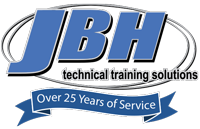The construction of the cell can be performed entirely by the trainees. Using industry-standard work orders, standard operating procedures, schematic diagrams and manufacturers technical manuals as resources, students assemble the frame and install the electrical wiring for the Maintenance Cell and add-on components. Once constructed, instructors can remotely insert faults in the electromechanical systems. Trainees can thus develop troubleshooting skills in a relevant, engaging manner. Each task includes validated industry standards providing measurable criteria for assessing students’ performance.
The JobMaster® 1600 Electromechanical Maintenance Cell is the ultimate capstone to any industrial maintenance / mechatronics program. The Electromechanical Maintenance Cell ensures relevant instruction by enabling a robust simulation of the workplace and a more valid delivery of career skills. Students learn to assemble, wire, maintain, and troubleshoot electromechanical systems just as if they were in the industrial environment. This results in the most effective authentic assessment of a trainees ability to succeed in the field of mechatronics or industrial maintenance.
Standard Features
The basic cell includes electrical power distribution and controls, wire and cable tray, wireways, conduit and equipment housings. Students gain enhanced understanding of industrial processes by installing, operating and troubleshooting sub-systems onto the cell including:
- Conveyor drive and control
- Part manipulator and controls with paint bake & cool process tunnel
- Industrial lighting
- Three-phase motor controls and Variable frequency drive
- DC motor controls and drive
- Lubrication components
- Pneumatic system and controls
- Instructor fault insertion system
Basic Maintenance Cell ZA01
Cell Frame
Work Order 1: Assemble the Base
Work Order 2: Assemble and Install the Conveyor Mount
Work Order 3: Install Pull Box, End and Feeder Tube Supports
Work Order 4: Install Crossbars and Top Members
Work Order 5: Inspect & Align Completed Frame
Enclosures
Work Order 6: Install Load Center
Work Order 7: Install Cable Trays
Work Order 8: Install Wireway
Work Order 9: Install Pull Boxes
Work Order 10: Install Equipment Enclosures
Work Order 11: Install Safety Disconnects
Work Order 12: Install Fuse Box and Station Transformer
Conduit & Fittings
Work Order 13: Cut and Ream Conduit
Work Order 14: Install Flexible Metal Conduit
Work Order 15: Install EMT Conduit Low Voltage & Circuit Protection
Work Order 16: Wire & Connect Main Power Cord
Work Order 17: Install & Connect Circuit Breakers
Work Order 18: Install Equipment Grounds
Work Order 19: Wire Fuse Box
Work Order 20: Wire Station Transformer
Work Order 21: Perform Megohmmeter Tests
Conveyor, Conveyor Drive & Controls ZA02
Conveyor
Work Order 1: Install Conveyor
Work Order 2: Install Conveyor Drive Components
Work Order 3: Install and Align Conveyor Drive Chain
Work Order 4: Install Conveyor Drive Safety Guard
Conveyor Controls
Work Order 5: Install and Connect Conveyor Drive Controls
Work Order 6: Install Emergency Stop Circuits
Work Order 7: Perform Circuit Continuity Tests
Work Order 8: Megger Test Conveyor Drive
Work Order 9: Test and Troubleshoot Conveyor Drive
Predictive/Preventive Maintenance
Work Order 10: Lubricate Conveyor Drive
Work Order 11: Verify Conveyor Alignment
Work Order 12: Verify Drive Chain Alignment
Work Order 13: Obtain Vibration Profiles
Part Manipulation ZA03
Part Manipulation
Work Order 1: Install Part Stacker and Feeder Tray
Work Order 2: Install Part Kicker
Work Order 3: Install Stacker Part Sensor Paint, Bake and Cool Tunnel
Work Order 4: Install Tunnel
Work Order 5: Install Paint Nozzles
Work Order 6: Install Paint Bake Heaters
Work Order 7: Install Cool Down Blower
Work Order 8: Install Part Count Sensor
Work Order 9: Install Paint Tunnel Status Indicators
Programmable Logic Controller (PLC)
Work Order 10: Install the PLC
Work Order 11: Rough-In PLC Power
Work Order 12: Program PLC
Work Order 13: Connect PLC Input Sensor Circuits
Work Order 14: Connect PLC Output Sensor Circuits
Work Order 15: Troubleshoot Paint, Bake & Cool System
Industrial Lighting Circuits ZA04
Industrial Lighting Circuits
Work Order 1: Install Fluorescent Task Lighting
Work Order 2: Install Low Bay Lighting
Work Order 3: Install High Bay Lighting
Work Order 4: Install Flood Lighting
Work Order 5: Install Hazardous Location Lighting
Work Order 6: Install Emergency Lighting
Work Order 7: Rough-In Lighting Circuits
Work Order 8: Megger Test Lighting Circuits
Industrial Power Circuits
Work Order 9: Install Wiring Devices
Work Order 10: Rough-In Wiring Device Circuits
Work Order 11: Megger Test Power Circuits
Work Order 12: Wire Lighting & Lighting Control
Work Order 13: Install and Test GFCI Circuit
Work Order 14: Troubleshoot Lighting and Power System
Variable Frequency Drive ZA05
Variable Frequency Drive
Work Order 1: Install Drive
Work Order 2: Rough-In Drive Wiring
Work Order 3: Megger Test VFD Wires
Work Order 4: Program and Test Drive
DC Motor Drive ZA06
Dc Motor & Drive
Work Order 1: Measure and Remove AC Motor
Work Order 2: Install DC motor
Work Order 3: Install DC drive
Work Order 4: Rough-in DC Drive Wiring
Work Order 5: Set Up and Test DC Drive (Manual – jumpers)
Work Order 6: Finalize Drive Wiring and Installation
Work Order 7: Troubleshoot DC Drive System
Fault Insertion System ZA07
Fault Insertion System Installation
Work Order 1: Install fault insertion sub panel
Work Order 2: Rough-in power circuit
Work Order 3: Rough-in fault insertion wiring
Work Order 4: Install and configure triggered faults
Work Order 5: Test triggered fault system
MECHANICAL CONSTRUCTION:
Dimensions
Assembled – frame only: (H x W x D): 101″ x 96″ x 72″ (2565mm x 2438mm x 1829mm)
Assembled – with all components: (H x W x D): 101″ x 114″ x 72″ (2565mm x 2896mm x 1829mm)
Weight
Trainer and components: 1400 lbs (635 kg)
Shipping: 1600 lbs (726 kg)
15″ (38mm) square anodized slotted aluminum frame with adjustable frame levelers
ELECTRICAL DISTRIBUTION COMPONENTS:
Electrical equipment enclosures: NEMA-1 standard, steel with hinged latch door, pre-drilled and pre-punched for installation
Wireways: NEMA-1 standard 16-guage steel, 4″ x 4″ (102mm x 102mm), with hinged cover, knockouts and end closure caps
Cable trays, Ladder-style: Aluminum, 12″W x 4″D x 144″L (305mm x 102mm x 3658mm) with 90-degree turndown
Cable trays, Basket-style: Aluminum, 6″W x 6″D x 84″L (152mm x 152mm x 2134mm)
Pull box enclosures: NEMA-1 Standard with knockouts and screw front cover
Safety disconnects
General duty, 3-phase, 3-pole, 240V, 30A cartridge-style fuse safety disconnects
Quick-make, quick-break operating mechanism provides for OSHA standard lockout/tagout procedures and meets UL 98 standards
Main Load Center
NEMA-1 load center supplies 12 1-pole circuits
125 amp, 3-phase, main breaker
Front cover with hinged door and 2-and 3-pole breakers
Station transformer
Type: Indoor/outdoor, wall mounted
Input: 208/240V single phase
Output: 120/110V at 1 kVA
Conduit and components
0.75″ (19mm) EMT
0.75″ (19mm) flexible metal
0.50″ (13mm) flexible, liquid-tight
Steel bodies, fittings, and clamps
Station/building Wire
14 AWG Type TFFN building wire, UL listed, stranded, PVC insulation and a nylon jacket
ELECTRICAL PROCESS COMPONENTS
AC motor: 208/240V, 3-phase, 1/3 HP (0.25 kW), 1725 rpm, 1.8 FLA, 56 C-face, TEFC, with a rigid mounting base
DC motor: 90V, 0.25 HP (0.18 kW), TENV, 1725 rpm, 3.0 FLA, 56 -face, with a rigid mounting base
Motor controllers: Motor contactor, overload relay, station transformer, pushbutton start / stop switches, hand-off-auto switch, pilot lamps
Variable frequency drive
208/240V 3-phase input
Standard equipment enclosure
Programming keypad
Digital readout of programming parameters
Analog, 10V, 0-60 Hz panel mounted speed control
Acceleration/deceleration/current boost control
Voltage/current/alarm monitoring
RS485 mod bus
Red pilot lamp, panel mounted, 240V
3-position For-Off-Rev selector switch with legend plate
DC drive
Standard equipment enclosure
Regenerative drive/braking
240/120VAC input
90V DC armature voltage output
Potentiometer speed control
Adjustable acceleration/deceleration/IR comp/max speed
Red pilot lamp, panel mount, 120V
Electric brake
Fail-safe operation
Single-phase and 240/460V 3-phase control circuits
NEMA 56 double-face Mounting standards
Manual release with automatic reset
Electrical signaling components
120VAC strobe-type status lights for paint/bake/cool process
Process paint cool down blower
115V, 60 Hz, PSC direct drive blower, 2450 RPM
CFM @ 0.000-In SP 150
Process sensors
Proximity switch, capacitive, 0.125 – 1.0″ (3-25mm) range,
NO output mode
Fiber-optic photoelectric switch, thru beam, NPN-SPST form
Process programmable logic controller
Inputs: 9 DC sinking or sourcing with diagnostic LEDs
Outputs: 7 AC relay with diagnostic LEDs
Input power requirements: 100-240VAC
Front panel LED indicators
HMI connector for direct front panel plug-in mounting
Expansion port for expansion modules
Communications port RS-232 or RS-485 adapter
Cartridge connector for optional memory or clock cartridge
Program capacity: 27,000 bytes, 4500 steps
RAM backup: lithium battery
Backup duration: 30 days
Instruction words: 35 basic and 46 advanced
Self-diagnostic functions
Accessories:
Computer link cable for connecting to a compatible computer to provide the following functions:
Monitoring of operating and I/O status
Monitoring/updating CPU module data
Uploading/downloading user programs
9-position I/O simulator
Programming software on CD-ROM
Printed user manual
INDUSTRIAL LIGHTING COMPONENTS
Low bay: 120/277VAC 175W, (H x W) 11.5″ x 12.5″ (292mm x 318mm) enclosed reflector with lamp
High bay: 120/208/240/277VAC, 250W metal halide lamp (H x W) 21″ x 18″ (533mm x 457mm)
Emergency: 120/277VAC, 10.8W @ 90 minutes output with 2 lamp heads, thermoplastic housing, 6V battery and charger
Floodlight: 120VAC, 70W HPS stem-mount lamp with die-cast aluminum housing, hinged door with toolless latch
Hazardous location: 300W incandescent glass globe, copper-free aluminum pendant mounted, explosion-proof, corrosion resistant
Fluorescent task: 120/277 VAC, 32W, general duty lamps with 48″ x 12″ x 4″ (1219mm x 305mm x 102mm) fixture, reflector and electronic ballast.
Industrial Lighting Controllers
2 pole rotary cam switch
120V 3-pole lighting contactor
120V 4-pole lighting contactor
120 VAC power relay DPST-NO
3-position switch, spring return to center OFF
MANUFACTURING MECHANICAL COMPONENTS
Process Conveyor
6″ W x 96″ L (152mm x 2438mm) flat belt-type mounted on a 2.5” (63.5mm) H, rugged-duty, hard-black-anodized aluminum frame
Standard 0.60” (1.5mm) above-belt side fences
Integral, direct-drive, 0.50″ (13mm) side-mount drive input shaft
Leveling-type hold down brackets
Belt tensioning device
Speed reducer
Type: right angle
Drive ratio: 60:1
Mounting: NEMA 56 C-face
Housing: cast iron
Bearings: ball bearing on input shaft, tapered roller bearings on output shaft
Gearing: hardened alloy steel worm, hardened forged bronze worm gear
Lubrication: oil sump supplied full
Seals: spring loaded, double lip
Configured to mount in tandem with the 56 C-face motor and 56 C-face brake forming a drive train
Chain drive
Drive input sprocket: #40 chain, 14-tooth, 0.625″ (16mm) bore with keyway
Drive output sprocket #40 chain, 20-tooth, with 0.50″ (13mm) split tapered bushing and keyway
Chain: #40, 0.50″ x 120″ (13mm x 3048mm) pitch
5 chain links, 5 offset links
0.50″ (13mm) rigid shaft coupling with keyway
Chain guard
Steel sheet metal covering full front, back, and sides
Safety equipment: 1 each NEMA-1, plunger-type, 2PDT, safety switch with 10-foot (3-meter) covered, 3 conductor
electrical cord
Process parts feeder
Feeder tube and base: 3.5″ x 3.5″ x 3.0″ (89mm x 89mm x 76mm), clear polycarbonate
Parts feeder ramp: aluminum, black finish
Pneumatic cylinder, 1.25″ (32mm) bore, 4.0″ (102mm) stroke, double acting, pivot/end mount, with two mounted flow
controls and mounting bracket
60 unfinished process parts included
Process paint tunnel
Material: 12 ga painted HRS
Dimensions: (L x W x H) 48.0″ x 6.0″ x 6.5″ (1219mm x 152mm x 165mm)
Pre-drilled and punched for component mounting
FAULT INSERTION/TROUBLESHOOTING SYSTEM
A configurable and programmable fault insertion system installed as a complete system integrated into the completed cell
Fault initiating and timing is either preset or actuated by wireless remote control
120 faults and related troubleshooting scenarios including:
- shorted/open/miswired components or wiring
- intermittent faults
- blown circuit fuses/electrical overloads/imbalance
- mechanical misalignment
- improper component lubrication
- equipment vibration
- improper pneumatic pressure/flow
Up to 4 faults may run simultaneously
DOCUMENTATION/OPERATING INSTRUCTIONS
Supplied for each task in standard industry format:
- work orders and operating procedures
- electrical schematics and mechanical drawings
- observable and measurable performance standards
- maintenance supervisor signoff /assessment
- All documentation deliverable via LearnMate
Click here to download a pdf data sheet.





















